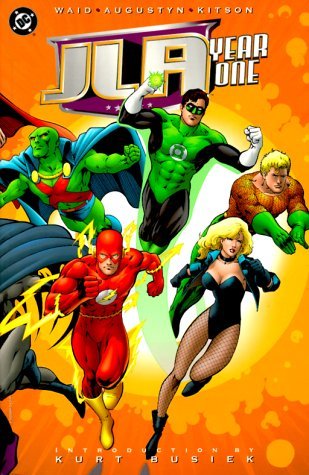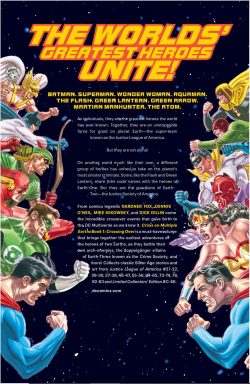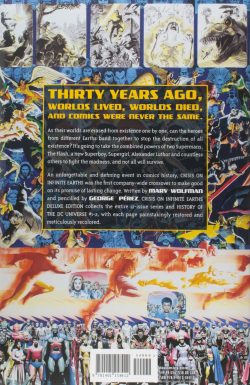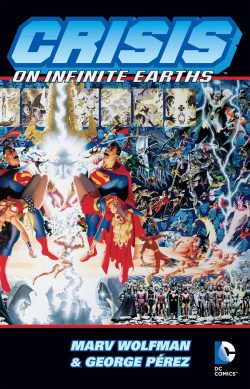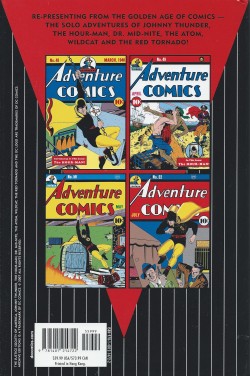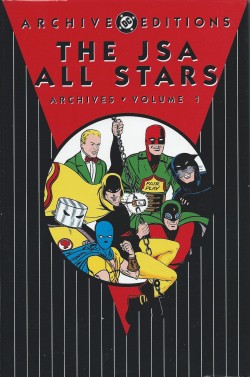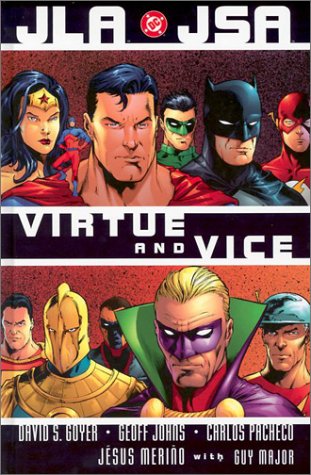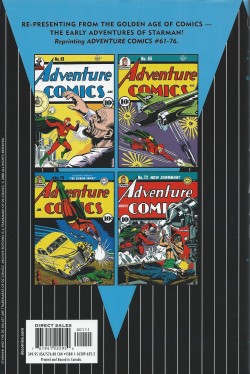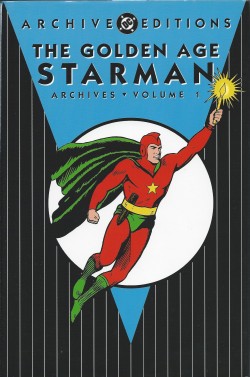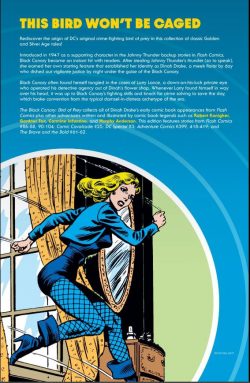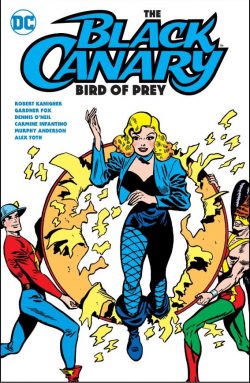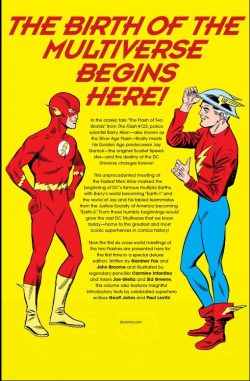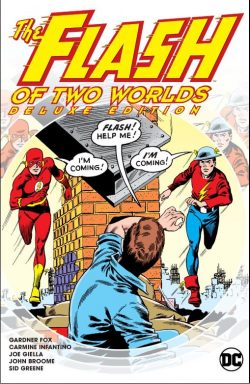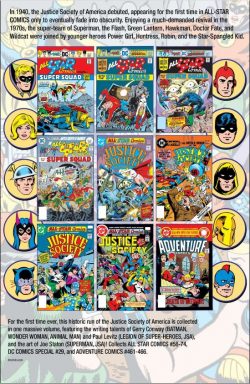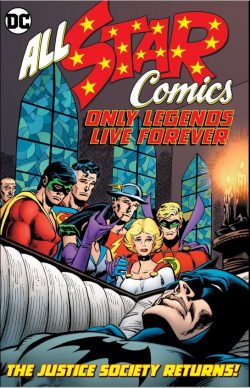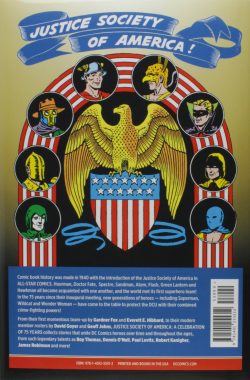
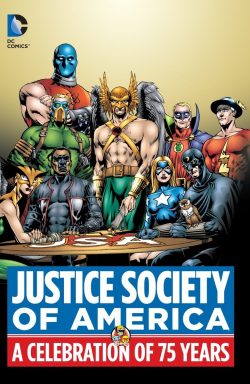
By Gardner Fox, Robert Kanigher, John Broome, Denny O’Neil, Paul Levitz, Roy Thomas, Len Strazewski, James Robinson, David Goyer, Geoff Johns, Mike Sekowsky, Dick Dillin, Joe Staton, Rich Buckler, Jerry Ordway, Arvell Jones, Mike Parobeck, William Rosado, Stephen Sadowski, Alex Ross, Dale Eaglesham & various (DC Comics)
ISBN: 978-1-4012-5531-2 (HB)
Win’s Christmas Gift Recommendation: Stunning Super Sagas Whatever the Season… 8/10
After the actual invention of the comicbook superhero – via the Action Comics debut of Superman in June 1938 – the most significant event in our industry’s history was the combination of individual stars into a like-minded group. Thus, what seems blindingly obvious to us with the benefit of four-colour hindsight was proven: consumers couldn’t get enough of garishly-hued mystery men, and combining a multitude of characters inevitably increases readership. Plus, of course, a mob of superheroes is just so much cooler than one…or one-and-a-half if there’s a sidekick involved…
The creation of the Justice Society of America in 1941 utterly changed the shape of the budding industry.
Following the runaway success of Superman and Batman, both National Comics and its separate-but-equal publishing partner All American Comics went looking for the next big thing in funnybooks whilst frantically concentrating on getting anthology packages into the hands of a hungry readership. Thus All Star Comics: conceived as a joint venture affording characters already in their respective stables an extra push towards winning elusive but lucrative solo titles.
Technically, All Star Comics #3 (cover-dated Winter 1940-1941 and released in December 1940) was the kick-off, but the mystery men merely had dinner and recounted recent cases and didn’t actually go on a mission together until #4, which had an April 1941 cover-date.
This superb hardcover and/or eBook commemoration comes from five years ago, gathering significant adventures of the pioneering paragons: specifically All Star Comics #4, 37, 55; Justice League of America #21, 22, 30, 47, 82, 83, 193; Adventure Comics #466; All-Star Squadron #67; Justice Society of America #10; JSA Returns: All–Star Comics #2; JSA #25; Justice Society of America vol. 2 #10 and Earth 2 #6, and – like all these generational tomes – follows a fixed pattern by dividing into chapters curated by contextual essays.
Here Roy Thomas’s history-packed treatise describes how leading characters from National-DC’s Adventure Comics and More Fun Comics and All-Star Publishing’s Flash Comics and All-American Comics were first bundled together in an anthological quarterly. Back then ‘A Message from the Editors’ asked readers to vote on the most popular…
The merits of the marketing project would never be proved: rather than a runaway favourite graduating to their own starring vehicle as a result of the poll, something radically different evolved. For the third issue, prolific scribe Gardner Fox apparently had the bright idea of linking all the solo stories through a framing sequence with the heroes gathering to chat about their latest exploits. With that simple notion that mighty mystery men hung out together, history was made and it wasn’t long before they started working together…
The anniversary amazement opens with Part I 1941-1950: For America and Democracy which hones in on those early moments, as All Star #4 eventually unites the costumed community ‘For America and Democracy’ with Fox and illustrators EE Hibbard, Martin Nodell, Bernard Baily, Howard Sherman, Chad Grothkopf, Sheldon Moldoff & Ben Flinton detailing individual cases for The Flash, Green Lantern, The Spectre, Hourman, Doctor Fate, The Sandman, Hawkman, The Atom and Johnny Thunder which coincide and result in a concerted attack on Nazi espionage master Fritz Klaver…
Pattern set, the heroes marched on against all foes from petty criminals to social injustice; aliens, mobsters and magical invaders until post-war tastes began shifting the formula…
All Star Comics #37 (1947) introduced ‘The Injustice Society of the World’ (November 1947) in a yarn by Robert Kanigher, Irwin Hasen, Joe Kubert, Alex Toth, Carmine Infantino & John Belfi. This sinister saga sees America almost entirely conquered by a coalition of super-villains before the on-the-ropes mystery men counterattack and ultimately triumph.
As superheroes plunged in popularity, genre themes predominated and it was a stripped-down team (Flash, GL, Wonder Woman, Black Canary, Hawkman, Atom and Dr. Mid-Nite) who faced a flying saucer scare in #55 and scoured outer space for ‘The Man Who Conquered the Solar System!’ (October/November 1955 by John Broome, Frank Giacoia, Arthur F. Peddy & Bernard Sachs).
Thomas returns for another educational chat as Part II 1963-1970: The Silver Age of Crisis focuses on the era that changed comics forever.
As I’ve frequently stated, I was one of the lucky “Baby Boomer†crowd who grew up with Julie Schwartz, Fox & Broome’s tantalisingly slow reintroduction of Golden Age superheroes during the halcyon, eternally summery days of the early 1960s. To me those fascinating counterpart crusaders from Earth-Two weren’t vague and distant memories rubber-stamped by parents or older brothers – they were cool, beguiling and enigmatically new.
…And for some reason the “proper†heroes of Earth-One held them in high regard and treated them with obvious deference…
It all began, naturally enough, in The Flash; pioneering trendsetter of the Silver Age Revolution. After successfully ushering in the return of the superheroes, the Scarlet Speedster – with Fox & Broome at the writing reins – set an unbelievably high standard for costumed adventure in sharp, witty tales of science and imagination, illustrated with captivating style and clean simplicity by Carmine Infantino.
The epochal epic that literally changed the scope of American comics forever was Fox’s ‘Flash of Two Worlds’ (Flash #123 September 1961 and not included here), establishing the existence of Infinite alternate Earths, multiple versions of costumed crusaders, and – by extension – the multiversal structure of the DCU. Every succeeding, cosmos-shaking annual summer “Crisis†saga grew from it.
Fan pressure almost instantly agitated for the return of more “Golden Age Greats†but Editorial bigwigs were hesitant, fearing too many heroes would be silly and unmanageable, or worse yet, put readers off. If they could see us now…
These innovative crossover yarns generated an avalanche of popular and critical approval (big sales figures, too) so inevitably these trans-dimensional tests led to the ultimate team-up in the summer of 1963.
A gloriously enthralling string of JLA/JSA convocations and stunning superhero wonderments begin with landmark opening salvoes ‘Crisis on Earth-One’ and ‘Crisis on Earth-Two’ (Justice League of America #21-22, August to September). In combination they comprise one of the most important stories in DC history and arguably one of the most crucial tales in American comics.
Written by Fox and compellingly illustrated by Mike Sekowsky & Bernard Sachs, the yarn sees a team of villains from each Earth plundering at will; meeting and defeating the mighty Justice League before imprisoning them in their own secret mountain HQ.
Temporarily helpless “our†heroes contrive a desperate plan to combine forces with the champions of another Earth to save the world – both of them – and the result is pure comic book majesty. It’s impossible for me to be totally objective about this saga. I was a drooling kid in short trousers when I first read it and the thrills haven’t diminished with this umpty-first re-reading.
This is what superhero comics are all about!
The second team-up is only represented by the concluding chapter ‘The Most Dangerous Earth of All!’ Justice League of America #30 (September 1964) reprised the team-up of the Justice League and Justice Society, after (evil) versions of our heroic champions-beings from third alternate Earth discover the secret of trans-universal travel.
Unfortunately, Ultraman, Owlman, Superwoman, Johnny Quick and Power Ring come from a world without heroes and see the crimebusting JLA and JSA as living practice dummies to sharpen their evil skills upon. With this cracking thriller the annual summer get-together became solidly entrenched in heroic lore, giving fans endless entertainment for years to come and making the approaching end of school holidays less gloomy than they could have been.
The fourth annual event was a touch different: flavoured by self-indulgent humour as a TV show drove the wider world bats. Veteran inker Bernard Sachs retired before the fourth team-up, leaving the amazing Sid Greene to embellish a gloriously whacky saga that sprang out of the global “Batmania†craze engendered by the twice-weekly Batman series…
A wise-cracking campy tone was fully in play, acknowledging the changing audience profile and this time the stakes were raised to encompass the destruction of both planets in ‘Crisis Between Earth-One and Earth-Two’ (not reprinted here) and ‘The Bridge Between Earths’ (Justice League of America #47, September 1966), wherein a bold but rash continuum-warping experiment drags two Earths towards an inexorable hyper-space collision. Meanwhile, making matters worse, an awesome anti-matter being uses the opportunity to break into and explore our positive matter universe whilst the heroes of two worlds are distracted by destructive rampages of monster-men Blockbuster and Solomon Grundy.
Peppered with wisecracking “hip†dialogue, it’s sometimes difficult to discern what a superb yarn this actually is, but if you can forgive or swallow the dated patter, this is one of the best plotted and illustrated stories in the entire canon.
Furthermore, the vastly talented Greene’s expressive subtlety, beguiling texture and whimsical humour added unheard-of depth to Sekowsky’s pencils and the light and frothy comedic scripts of Gardner Fox.
This exercise in fantastic nostalgia continues with both chapters of a saga wherein alien property speculators seek to simultaneously raze Earths One and Two in ‘Peril of the Paired Planets’ (#82 August 1970 by O’Neil, Dillin & Joe Giella) and only the ultimate sacrifice by a true hero can avert trans-dimensional disaster in ‘Where Valor Fails… Will Magic Triumph?’ (#83 September)
Part III: Bronze Age and Beyond 1971-1986 returns to independent status and stories as – following another pertinent briefing from Thomas – we next focus on a time when the team was on its second career after decades in retirement.
Set on parallel world Earth-2, the veterans were leavened with teen heroes combined into a contentious, generation-gap fuelled “Super Squadâ€. Those youngsters included a grown up Robin, Sylvester Pemberton, the Star-Spangled Kid (a 1940s teen superhero who had been lost in time for decades) and a busty young thing who quickly became the feisty favourite of a generation of growing boys: Kara Zor-L – AKA Power Girl.
It starts with a little history lesson as Paul Levitz & Joe Staton reveal how and why the JSA went away. In ‘The Defeat of the Justice Society’ (Adventure Comics #466 December, 1979) they expose the reason why the team vanished at the beginning of the 1950s as the American Government cravenly betrays its greatest champions during the McCarthy witch-hunts: provoking the mystery men into voluntarily withdrawing from public, heroic life for over a decade – until the costumed stalwarts of Earth-One started the whole Fights ‘n’ Tights scene all over again…
When Roy Thomas left Marvel for DC, he made a lifetime dream come true by writing his dream team… sort of. Justice League of America #193 (August 1981) featured a “Prevue†insert mini-comic featuring the ‘All-Star Squadron’. Thomas, Rich Buckler & Jerry Ordway launched a series of new stories set in the immediate aftermath of the attack on Pearl Harbor, told in real time and integrating published tales from the Golden Age into an overarching continuity. Here the JSA were augmented by contemporaries from other companies acquired by DC over the years – such as Plastic Man, Firebrand and Uncle Sam – and minor DC stalwarts like Liberty Belle, Johnny Quick and Robot Man. This prequel tells of December 6th 1941 and how the JSA heroes are attacked by villains from their own future as a mastermind seeks to alter history, leaving President Franklin Delano Roosevelt to issue a clarion call to all of Democracy’s other champions…
After an impressive and entertaining 5 year run that skilfully negotiated the rewriting of continuity during Crisis on Infinite Earths, the series ended with All-Star Squadron #67 (March 1987) as Thomas, Arvell Jones & Tony DeZuñiga recondition ‘The First Case of the Justice Society of America’ from All Star #4 and reveal how Nazi Fritz Klaver met justice…
Industry insider Ivan Cohen then reveals how things changed after the Crisis as a taster for Part IV: The JSA Returns 1992-2007 which opens with the last issue of Justice Society of America volume 1 (#10, May 1993). The series had concentrated on adventures of the aging heroes in modern times and ‘J.S.A. No More?’ by Len Strazewski, Mike Parobeck & Mike Machlan closed a superb and joyously fun run with the geriatric wonders polishing off ancient wizard Kulak and saving humanity from an army of unquiet ghosts and zombies…
The heroes were again rebooted six years later via a series of one-shots bracketed by a 2 issue miniseries and here James Robinson, David Goyer, William Rosado, John Dell & Ray Kryssing conclude the WWII-set battle against mystic marauder Stalker with ‘The JSA Returns, Conclusion: Time’s Arrow’ in JSA Returns: All-Star Comics #2 (Late May 1999).
All that attention led to a spectacular new series, which gained new fans for the old soldiers by turning the team into a mentoring service for new heroes. It must have been hard to select a sample from that era but the editors here went for ‘The Return of Hawkman: Seven Devils’ (JSA #25, August  2001 by Goyer, Geoff Johns, Stephen Sadowski, Michael Bair, Dave Meikis, Paul Neary & Rob Leigh).
But first, a slight digression…
Hawkman is one of the oldest and most revered heroes of all time, premiering in Flash Comics #1 (January 1940). Although created by Gardner Fox & Dennis Neville, the most celebrated artists to have drawn the Winged Wonder are Sheldon Moldoff and Joe Kubert, whilst a young Robert Kanigher was justly proud of his later run as writer.
Carter Hall was a playboy archaeologist until he uncovered a crystal knife that unlocked his memories. He realised that once he was Prince Khufu of ancient Egypt, and that he and his lover Shiera had been murdered by High Priest Hath-Set. Moreover, with his returned memories came the knowledge that his love and his killer were also nearby.
Using his past life knowledge, he fashioned a costume and flying harness, hunting his killer as the Hawkman. Once his aim was achieved he and Shiera maintained their “Mystery-Man†roles to fight modern crime and tyranny with weapons of the past.
Disappearing as the Golden Age ended, they were revived by Julie Schwartz’s crack creative team in the 1960s, but after a long career involving numerous revamps and retcons, the Pinioned Paladin “died†during the Zero Hour crisis.
The interconnection between all those iterations is resolved after time-lost Jay The Flash Garrick awakens in ancient Egypt, and learns from that era’s superheroes – Nabu, the Lord of Order who created Doctor Fate, Black Adam and Khufu himself – the true origins of Hawkman whilst in the 21st century, the modern Hawkgirl discovers his connection to alien cop Katar Hol, the Hawkworld Thanagar and true power of empowering Nth Metal.
When Hawkgirl is abducted to the aforementioned Thanagar by its last survivors, desperate to thwart the schemes of the insane death-demon Onimar Synn, the JSA frantically follow and Carter Hall makes his dramatic return from beyond to save the day in typical fashion before leading the team to magnificent victory in this concluding chapter…
There have been many attempts to formally revive the team’s fortunes but it wasn’t until 1999, on the back of both the highly successful rebooting of the JLA by Grant Morrison & Howard Porter and the seminal but critically favoured modern Starman by James Robinson, that the multi-generational team found a new mission and fan-base big enough to support them. As the century ended the original super-team returned and have been with us in one form or another ever since.
Called to order after Infinite Crisis and Identity Crisis, this JSA saw the surviving heroes from WWII as teachers for the latest generation of young champions and metahuman “legacy-heroesâ€: a large, cumbersome but nevertheless captivating assembly of raw talent, uneasy exuberance and weary hard-earned experience.
Taken from truly epic storyline ‘Thy Kingdom Come’, Geoff Johns, Alex Ross, Dale Eaglesham, Ruy Jose & Drew Geraci’s ‘What a Wonderful World’ comes from Justice Society of America vol. 2 #10 (November 2007): expanding, clarifying and building on heroes introduced in the landmark 1996 Mark Waid & Alex Ross miniseries Kingdom Come, and its belated sequel The Kingdom.
The elder Kal-El from that tragic future dystopia has crossed time and dimensions to stop his world ever forming and not even awakened god Gog or his new allies will stop him. ‘What a Wonderful World’ sees Tomorrow’s Man of Steel disclose how the heroes and their successors almost destroyed the planet (with flashback sequences painted by Alex Ross) before (another) Starman explains his own connection to all the realms of the multiverse. Initially suspicious, the JLA come to accept the elder Man of Steel, but elsewhere, a deadly predator begins to eradicate demi-gods and pretenders to divinity throughout the globe…
Having grown too large and unwieldy again, DC’s continuity was again pruned and repatterned in 2011, leading to a New 52 as sampled here in concluding segment Part IV: Revamp 2012. Accompanied by another Cohen text briefing, ‘End Times’ by Robinson, Nicola Scott & Trevor Scott comes from Earth 2 #6 (January 2012) with a recreated JSA operating on a restored alternate Earth, but one where an attack from Apokolips has created a living hell for the survivors of humanity, and a small group of metahumans such as Flash, Hawkgirl and Green Lantern struggles to keep humanity alive and free…
With covers by Hibbard, Irwin Hasen, Arthur F. Peddy & Bernard Sachs, Sekowsky, Murphy Anderson, Joe Giella, Neal Adams, Dick Dillin, George Pérez, Tom Grindberg & Tony DeZuñiga, Mike Parobeck, Dave Johnson, Andrew Robinson, Alex Ross, Ivan Reis & Joe Prado, this magnificent celebration of the premiere super-team is a glorious march down memory lane no fan can be without. Whether in sturdy hardback or approachable electronic format, this titanic tome must be yours…
© 1941, 1947, 1950, 1963, 1964, 1966, 1970, 1979, 1981, 1986, 1992, 1999, 2001, 2007, 2012, 2015, DC Comics. All Rights Reserved.
